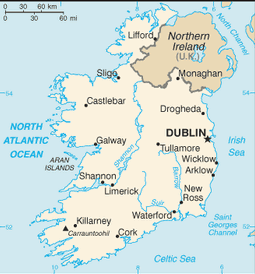The Table of Content


Family Research:






 

Available Help:



|

The name Ireland (in modern Irish, Éire) derives from the name of the Celtic goddess Ériu with the addition of the Germanic word land.
Ireland is the third-largest island in Europe and the twentieth-largest island in the world. It lies to the north-west of continental Europe and is surrounded by hundreds of islands and islets. To the east of Ireland is the island of Great Britain, separated by the Irish Sea. A sovereign state named Ireland, the same name as the island, covers five-sixths of the island. Northern Ireland, a part of the United Kingdom, located in the northeast of the island covers the remainder.
The population of Ireland is estimated to be slightly over six million. Nearly 4.5 million people are estimated to reside in the Republic of Ireland and an estimated 1.75 million reside in Northern Ireland. This is a significant increase from a modern historic low of 4.2 million in the 1960s. However, it is still much lower than the peak population of over 8 million in the early 19th century prior to the Great Famine.
The first settlements in Ireland date from around 6000 BC. Celtic migration and influence had come to dominate Ireland by 200 BC. Relatively small scale settlements of both the Vikings and Normans in the Middle Ages gave way to complete English domination by the 1600s. Protestant English rule resulted in the marginalization of the Catholic majority, although in the north-east, Protestants were in the majority due to the Plantation of Ulster.
Ireland became part of the United Kingdom of Great Britain and Ireland in 1801. A famine in the mid-1800s caused large-scale death and emigration. The Irish War of Independence ended in 1921 with the British Government proposing a truce during which the Anglo-Irish Treaty was signed, creating the Irish Free State. This was a Dominion within the British Empire with effective internal independence but still constitutionally linked with the British Crown.
Northern Ireland, consisting of six of the 32 counties of Ireland, which had been established in 1921, immediately exercised its option under the treaty to retain its existing status within the United Kingdom. In 1937, a new constitution replaced the Irish Free State with a wholly independent state called Ireland, which later left the Commonwealth to become a republic in 1949. In 1973, both parts of Ireland joined the European Community. Conflict in Northern Ireland led to much unrest from the late 1960s until the 1990s, which subsided following a political agreement in 1998.
  
|